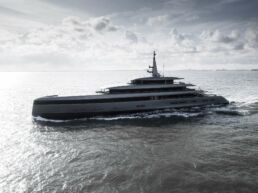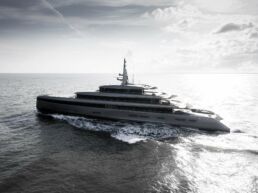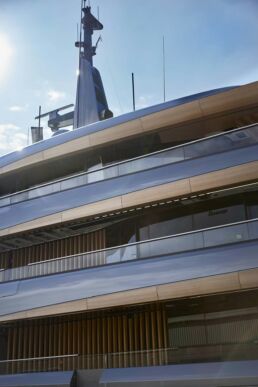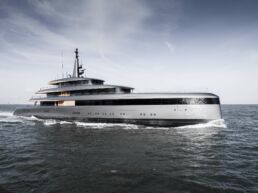Feadship's first launched superyacht, OBSIDIAN of 2023, sets a new standard for reducing carbon emissions.
Feadship is moving closer to its ambition of creating carbon-neutral superyachts by 2030. The newly constructed 84.20-meter Obsidian marks the beginning of Feadship’s latest line of large yachts, enhancing carbon reduction efforts through hull designs optimized for cruising rather than top speeds, managing weight more effectively, improving electric propulsion technology, and the capability to operate engines on a biofuel known as HVO. The yacht underwent tests with its generators powered by this biofuel, achieving a 90 % reduction in carbon emissions compared to yachts powered by traditional fossil fuels.
The design brief for the yacht aimed to make it more energy-efficient and emit fewer carbon emissions than Feadship’s pioneering hybrid yacht, Savannah, introduced in 2015. Reducing environmental impact by over 30% seemed like a significant challenge. Despite this, the entire design phase for Obsidian lasted throughout the peak of the global pandemic.
During the COVID-19 lockdowns, no designers, engineers, or other team members could work together in person.

In collaboration with his team, Bram Jongepier, a Senior Designer at Feadship De Voogt Naval Architects, has created a sustainability index. This index offers extensive advice on how a yacht’s design and operation affect its carbon and ecological footprint.
Minimizing carbon dioxide emissions is a primary goal, but Feadship is taking additional steps by considering its ships’ complete ecological footprint. The scrutiny includes the release of nitric oxide and nitrogen dioxide (NOx), particulate matter, hydrocarbons, and the environmental effects of materials such as steel, aluminum, fairing compounds, antifouling treatments, teak, and interior finishes, among others. Along with carbon dioxide emissions, we refer to this as the environmental footprint, which is assessed through life cycle assessments (LCA).

Jongepier’s project is recognized as YETI, the Yacht Environmental Transparency Index.
Based on the principle that one cannot manage what one cannot measure, the computer models that assess the environmental effects of CO2, NOx, particulate matter, use of shore power, and the production of fuel have been made openly accessible by Feadship to members of the Water Revolution Foundation, an association in the yachting sector focused on promoting sustainability in the superyacht market through teamwork and innovation. This initiative resulted in a Joint Industry Project (JIP) involving twenty key players in the yachting sector under the Water Revolution Foundation’s banner.
The YETI JIP developed a device that, with additional data from partners such as engine producers, forecasts the environmental footprint of a year of operation in a yacht’s life cycle. Jongepier believes that YETI accurately represents 90 % of a yacht’s life cycle, with each new construction contributing more data. Obsidian is projected to achieve a 27% reduction in its overall environmental footprint compared to a similar-sized yacht launched five years ago, powered by fossil fuels, and a 60 % reduction when utilizing HVO.

For Obsidian, the initial phase involved leveraging the cutting-edge technology from the award-winning Savannah. By utilizing Feadship’s Advanced Electrical Drive (FAED) program for diesel-electric hybrid power, Obsidian boasts a four times greater electrical storage capacity than its inaugural hybrid yacht, Savannah. This design eliminates the need for drive shafts and rudders, reducing the drag typically associated with these components. The yacht’s propulsion and steering are managed by a set of Veth contra-rotating thrusters, which serve dual purposes. Veth’s expertise in developing compact systems for river-based vessels was deemed an ideal match for a yacht designed for shallow waters.
The energy source for Obsidian is a 4.5 MWh battery bank, which is recharged by four generators. These include two large and two small custom, variable speed units, modified CatC32 engines, and permanent magnet alternators that adjust power output as necessary. Unlike Savannah and Lonian, which operated on 560 volts DC, Obsidian features a DC system capable of handling a staggering 1,000 volts, as the yacht is entirely powered by electricity. A total of 560 battery modules are stored in a specialized chilled room in the middle of the tank deck, showcasing another advantage of the hybrid system: the components are no longer required to be closed. The thrusters are strategically placed for steering and optimizing water flow. At the same time, the generators, their exhaust systems, batteries, and electrical switchboard are positioned elsewhere to ensure the most efficient weight distribution and ease of access for the crew. Obsidian is projected to cruise for 35 nautical miles at 10 knots solely on battery power. While docked, the batteries will be quiet for 10-15 hours.

However, simply improving propulsion wouldn’t achieve the necessary fuel savings. Upon examining Obsidian with the YETI tool, it was found that roughly 60% of the energy used was dedicated to operating the yacht’s lifestyle features – including air conditioning, heating, hot water, lighting, cooking, entertainment electronics, swimming pools, and laundry services. The goal was to reduce the energy required to support the yacht’s “hotel” load.
To address this, several significant innovations were incorporated into Obsidian to target these areas. These included peak load shaving and lowering the demand for heating, ventilation, and air conditioning (HVAC) through the automated control of cooling areas for guests and crew. However, since energy production also generates heat, capturing and utilizing the excess heat for other uses became a primary objective. For every 100kW of energy produced by fossil fuel combustion in a typical internal combustion engine, only 35 to 40% is usable mechanical energy, with the rest being heat, usually released into the water or exhaust gases.
Feadship’s design and engineering team started by creating a more extensive system than just using generator cooling water to warm a swimming pool, a standard method among many superyacht builders.
Given that 25% of the “hotel” energy demand is for generating heat, all heat-related needs were identified. The most significant consumer was air conditioning.
This was because the HVAC system had to cool the incoming fresh air to about 7 degrees Celsius to effectively dehumidify the surrounding sea air. However, heating systems had to raise the air temperature to the desired level for each room to prevent the interior from feeling too cold.
SHARING IS CARING - THANK YOU!
About Publisher
 Ahoy, I’m René, the “captain” of this luxury yacht blog, and found my passion for the big ones at the age of 17. I have grown up with sailing since a little child. I have an education in Business Informatics and specialized in digital media solutions (alongside luxury yachts) like Online-Marketing, User Experience Design et cetera. My home port is in Oldenburg, Germany next to Lürssen and Abeking & Rasmussen. More about yachtemoceans
Ahoy, I’m René, the “captain” of this luxury yacht blog, and found my passion for the big ones at the age of 17. I have grown up with sailing since a little child. I have an education in Business Informatics and specialized in digital media solutions (alongside luxury yachts) like Online-Marketing, User Experience Design et cetera. My home port is in Oldenburg, Germany next to Lürssen and Abeking & Rasmussen. More about yachtemoceans